Culture of chemical sales teams
A tale of two divisions Pharma chemical sales team vs Cosmetic chemical sales team – A contrast in the HOW and WHY.
Abstract (abbreviated)
This study happened accidentally. Training sessions were conducted with the sales teams of a multinational chemical company. There are a variety of divisions within the company offering their chemical products used as raw material components in many other products. Some of the divisions include: Human Nutrition, Animal Nutrition, Pharmaceutical Chemicals, Cosmetic Chemicals, and many types of industrial chemicals. As a component of the sales training program, we provided a four-dimension behavioral instrument (DISC-based) and a Motivators instrument (based on Allport’s research; and the Study of Values instrument).
The scores of both instruments are interpolated into the Mindset Metrics design for ease of interpretation. There were nuances of differences observed between the team means based on the DISC instrument, and more remarkable differences observed in the Values/Motivators instrument. The most remarkable set of differences emerged from a comparison of the Pharma-chem and Cosmetic-chem teams. It is this comparison that the brief paper will explore.
Perceptions… and Reality



It’s said that one’s perception is their reality. In listening to the Pharma-Chem sales team talk about their perceptions of the Cosmetic-Chem team, we heard phrases like: ‘They’re hyper people; overly excited; loud; wacko; wild & crazy people; (low quality control); etc.’ In our observation, they were describing the uniqueness, outside-the-box thinking, innovation, new ways of doing things, creativity, and other topics that are frequently addressed at a cosmetic counter when a customer is asking about products. “Oh, try out this trendy new color!” “This is the newest innovation in foundations!” “Here is our most popular wild fragrance!” In between the Cosmetic Chemicals and the end-user at the retail sales counter, are the chemical buyers and formulators at the cosmetics company. These experts design and formulate the cosmetics. They look at their products and typically want to provide new and innovative ideas for the end-users of cosmetics. Namely, the women (and men) who want to try something new.
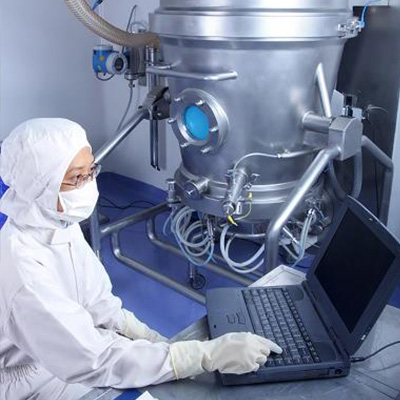

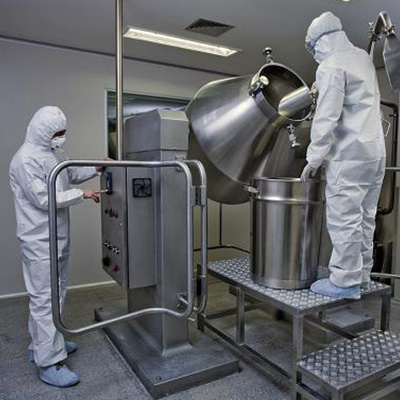
Change to different tables at the other side of the room. We listen to the Cosmetic Chemical sales team as they discuss their perceptions of the Pharma-Chem team, and we hear different statements, like: ‘They’re tight-a**ed people; reclusive; withdrawn; overly serious; secretive; etc. In our observation, they were describing the caution, concern, worry, hope, questions and other topics that are frequently addressed at a pharmacy counter when a customer is asking about their prescription. “This is the most reliable pharmaceutical to treat your illness.” “They’ve done a lot of research on this formula, and we’re seeing very stable results.” “Here is the most widely used formula for your specific disorder.” In between the Pharmaceutical Chemicals and the end-user patient at the pharmacy counter, are the chemical buyers and formulators at the pharmaceutical company. These experts design and formulate the pharmaceuticals. They look at their products and typically want to provide the safest drugs possible with the fewest side effects for their end-users. Namely, the patient at the pharmacy counter who wants to feel better and overcome their disorder.
A word about quality control.
The Pharma-Chem salespeople perceived the Cosmetic-Chem team as having lower quality control. They weren’t exactly correct in that perception, they simply weren’t looking at the bigger-picture view. It’s a matter of tolerances. For example, if in a foundation or lipstick formulation, a batch of chemicals was mixed with one-half percent more (or less) beeswax, the formula may still be useable in the cosmetic. Additionally, look at the label of any personal care product that you use on a daily basis. This includes deodorant, cosmetics, shaving cream, and even toothpaste. Each has a label stating a message similar to: “If a rash develops, discontinue use.” Translation: If this product doesn’t work for you, then throw it away. Note that the message doesn’t say, “Call your physician, call your attorney and prepare a lawsuit.” On the contrary, if it causes an irritation and doesn’t work for you, throw it away.
Another word about quality control.
The Cosmetic-Chem salespeople perceived the Pharma-Chem team as having hyper-high, over-the-top quality control. They weren’t wrong, they simply weren’t looking at the bigger-picture view. It’s a matter of tolerances. For example, if in a Pharma-Chem formulation, a batch of chemicals was mixed with one-half percent more (or less) of an ingredient, the formula may be rendered unsafe, ineffective, or even deadly. Additionally, look at the label of any pharmaceutical product that you receive from the pharmacy. Each has a technical sheet printout stating a detailed message listing drug interactions, and contraindications. Additionally, there’s a message about any reactions to the medicine that urges the patient to call their physician or health care provider immediately. This is intended for the patient’s long-term safety and wellness. This is more serious and intense than a contact rash, and it could be deadly
The ‘Reveal’ and the Results
When the teams participated in a combined-group debrief of their Behavior (HOW) and Motivator (WHY) results, the ‘reveal’ was enlightening. What’s their HOW? The Pharma-Chem sales professionals showed a higher tendency toward Stability behaviors, and the Cosmetic-Chem showed a higher tendency toward Change behaviors, as shown in a portion of the wheel charts below.
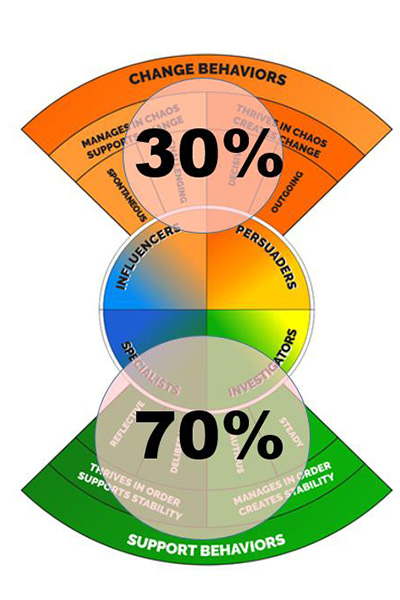
Pharma-Chem Sales Professionals.
What’s their HOW? HOW do they sell?
Tending toward Cautious, Deliberate, Steady, and Reflective.
They sell ‘fine-chemicals’ of pharmaceutical grade; very high accuracy in formulations; very high detail and stringent tolerance for accuracy.
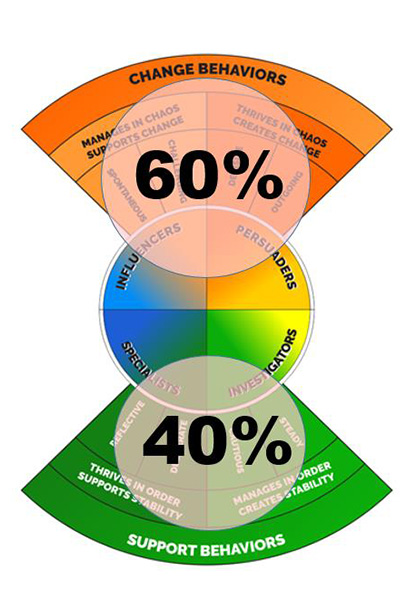
Cosmetic-Chem Sales Professionals
What’s their HOW? HOW do they sell?
Tending toward Decisive, Outgoing, Challenging, and Spontaneous.
They sell chemicals of cosmetic grade; moderately high accuracy in formulations; and used in foundations, facial cosmetics, soaps, and other personal care products.
What’s their WHY?
In brief, this was the most enlightening portion of the ‘reveal’ of the team results.
The Pharma-Chem sales professionals
showed stronger Motivators drives toward the Tradition Motivators including, Order, Helping, and Utility. We observed additional themes in the Innovation Motivators including Knowledge (very strong; do your homework and research), and Financial Security (pharmaceutical research is very costly).
The Cosmetic-Chem sales professionals
showed stronger Motivators drives toward the Innovation Motivators including, Uniqueness, Freedom, and Aesthetics. We observed additional themes in the Tradition Motivators including Helping (helping customers improve their physical image), and Financial Security (cosmetic and personal care marketplace is very competitive).
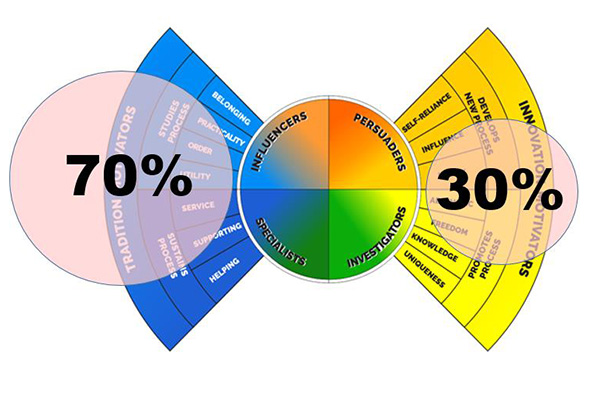
Pharma-Chem Sales Professionals.
What’s their WHY? WHY do they sell?
Motivation themes:
Do your homework, be accurate!
Win in the marketplace! Make profits!
Guard your trust level! NDAs on research!
Extremely high quality control!
Lives depend on it!
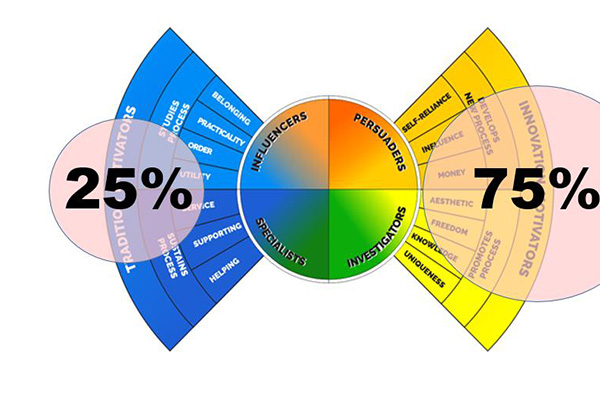
Cosmetic-Chem Sales Professionals
What’s their WHY? WHY do they sell?
Motivation themes:
Be unique and different!
Win in the marketplace! Make profits!
Make your customer happy with their look!
We’re your friends, try something new!
If it doesn’t work, throw it away!
What’s most important to remember in ALL of the above is that no one is wrong. Neither of the teams are wrong, and each team brings valuable behaviors and motivational drives to their unique sales marketplaces. The biggest take-away from the teams at the debrief event: They gained a much greater appreciation of their colleagues in the other divisions. The Pharmaceutical sales professionals realized that the field of cosmetics sales requires a different culture ‘fit’ from the salesperson. Likewise for the Cosmetic sales professionals, they gained an appreciation of the stringent and extreme quality control necessary for Pharma-chem sales. When asked, each group said they could sell in the other division, but it would require a greater ‘stretch’ of their Behaviors and Motivators to be successful. A rich and deep conversation followed about Behaviors, Motivators, and ‘job role fit’ in the various divisions and specific roles within the company.
In a sixty-day follow-up contacts with the team leaders and managers: In the Pharmaceutical division hallways, there were no more conversations about the Cosmetic sales team as being ‘wild, wacky, loud, freeform and crazy.’ The same was observed in the Cosmetic division hallways. No more labeling of the Pharma-sales professionals as tight-a**ed, withdrawn, and overly serious. Both divisions carried a new respect for their colleagues, and a new realization about the culture of job role fit.
What we learned about Teams
This ‘accidental’ study has been replicated numerous times since the early 1980s and in a variety of industries. There is a slightly different set of Behaviors and Motivators that achieves the best results in sales roles in the agricultural industry, as we learned in several years of research with the AFIA (American Feed Industry Association). Music is called a ‘universal language,’ and we found nuances of differences and trends between those who prefer front-of-house roles in sales versus those who preferred back-of-house roles in service and repair roles through our research with NAMM (National Association of Music Merchants). And, many other niche markets in vertical industries.
An additional and powerful observation in conclusion:
Winning sales teams in specific vertical industries tend to emulate the Behaviors and Motivators of their clients and customers. That is, one of the primary areas of agreement and overlap between sales professionals and their clients / customers in vertical industries is their shared HOW and WHY. This explains (in retrospect) many of the conversations we’ve heard from colleagues who tell us that they feel a ‘good fit’ in the company in which they landed, even after a series of self-led job changes in the same field. This Mindset Metrics model isn’t designed for pre-hire screening or hiring models. There are many good to great products on the street that do that granular analysis. Mindset Metrics is aimed at all members of an organization to help amplify and illuminate their strengths. Additionally, our Brainergy messages provide each member with on-going motivation to keep everyone optimally engaged, centered, and focused for maximum effectiveness.

